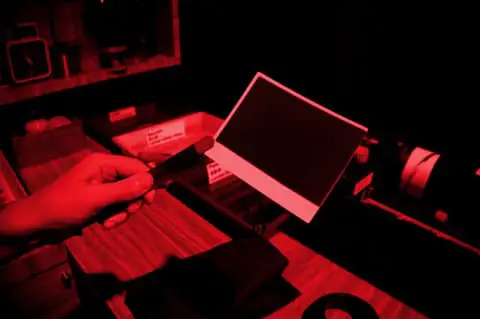Do you remember the first time you ever used a Polaroid camera? The excitement of waiting for that little white square to develop and reveal your photo?
These days, instant cameras are all the rage again, and with them comes the debate over whether Polaroids develop better in light or dark. So which is it?
Generally, it’s best to develop your Polaroid film in a dark or dimly lit room. Since the developing process is a chemical reaction, light can interfere. However, you can still develop your Polaroid film if you don’t have access to a dark room.

There’s a lot of debate over whether polaroids develop better in light or dark.
Some people swear by developing them in light, while others find that the darkroom produces better results every time. Keep reading to learn how to get the perfect Polaroid every time.
Is A Light Or Dark Room Better To Develop Your Polaroid?
If you’ve ever taken a Polaroid photo, you know that developing the picture can be pretty magical. But have you ever considered whether developing your polaroids in light or darkness is better?
There’s lots of debate on the light vs. dark room subject!

Some people swear by setting them in light, while others find that a dark room produces better results every time.
Generally, a dark room will be the better option for developing your image. This is because polaroids are photosensitive, meaning that they react to light. If your polaroid is exposed to too much light during the developing process, it can end up with faded colors or streaks.
Here are the pros and cons of developing photos in light and dark rooms:
| Pros | Cons | |
| Light Room | – You can see the image as it develops. – It’s faster than developing in the darkroom. | – The light can sometimes distort the colors of the image. – It can be difficult to control exposure levels. – The results may not be consistent from one image to the next. |
| Dark Room | – The darkness helps preserve the colors in the image. – It’s easier to control the amount of light exposure. – You’re more likely to get consistent results from one image to the next. | – You can’t see the image as it develops, so you must wait until the end to see the results. – It takes longer than developing in light. |
As you can see, both polaroid development methods have pros and cons. It comes down to personal preference in the end.
Do Polaroids Need Light To Develop?

The main benefit of developing your polaroids in light is that it’s much faster than using a darkroom. All you require is a few seconds of sunlight or artificial light exposure, and your picture will start to develop right before your eyes!
This is incredibly convenient if you’re taking Polaroids at an event or gathering where you don’t have access to a darkroom.
However, some people find their polaroids are not developing properly when exposed to light.
If you’re not careful, parts of your picture may end up over or underexposed, giving you an uneven image. Additionally, developing in light can sometimes cause colors to appear faded or washed out.
What Helps Polaroids Develop Faster?
When you take a Polaroid picture, the film inside the camera is exposed to light, causing a chemical reaction that produces the image. However, this reaction doesn’t happen instantaneously – it takes a few minutes for the image to develop fully.
You can do these things to speed up the process, however.
First, ensure that the camera is in a well-lit area – exposure to sunlight will help the chemicals work faster. Second, gently shake the Polaroid film after taking the picture – this helps to spread the chemicals evenly and prevents them from pooling in one spot.
Finally, don’t be afraid to use a little heat – a hairdryer on a low setting can help speed up the development process. By following these tips, you’ll be able to enjoy your Polaroid pictures in no time!
And here are some useful tips on how to preserve Polaroid pictures after they’ve developed.
Do You Put Polaroids in the Light or Dark?
During the development process, it’s best to keep Polaroids in the dark. Exposing them to light immediately after taking the photo can negatively affect the image quality and color balance. After you’ve taken a picture, place the photo face-down or shield it from light for about 10-15 minutes, allowing the chemicals to develop fully. Once the development time has passed, your Polaroid photo can be safely exposed to light without affecting the final image.
Do Polaroids Develop Better In The Dark?

Using a darkroom to develop your polaroids may take longer than doing it in light. Still, many feel it’s worth the extra time and effort. One of the main benefits of developing in darkness is that it allows for more even development. So you’re less likely to end up with an under or over-exposed final product.
Additionally, some people find that dark pictures have richer colors and greater contrast than those developed in light. However, this isn’t always the case—it depends on your specific film and camera.
Why Are My Polaroids Coming Out Blurry?
If your polaroids are coming out blurry, there are a few potential causes. First, make sure that the Polaroid lens is clean. If there is any dirt or debris on the lens, it can cause the image to appear blurry.
Second, check the focus setting on your camera. If the focus is set to infinity, it can cause distant objects to appear blurry.
Third, make sure that your subject is well-lit. The image will appear dark and blurred if there is not enough light.
Finally, if your Polaroid uses a flash, try moving the light closer to your subject. By following these photography tips, you should be able to get clear, sharp polaroids.
Why Are My Polaroids Coming Out Faint?

The most common reason your polaroids are coming out faint is that the film isn’t fully seated in the camera. Be sure to check that the film is installed correctly according to the manufacturer’s instructions.
Another possibility is that the batteries in your camera are running low. Try replacing the camera’s batteries with fresh ones to see if that makes a difference.
Finally, the light seal around the film door may not be airtight.
A small amount of light leakage can cause pictures to come out faint. If you believe this is the case, try covering gaps around the door with black electrical tape.
With some camera troubleshooting, you should be able to get your Polaroids looking great again in no time!
Should You Keep Polaroids in the Dark?
Keeping your freshly taken Polaroids in the dark while they develop is generally recommended. Shielding the photos from light during development helps ensure the best image quality and color accuracy. Once the development process is complete (usually around 10-15 minutes), your Polaroid photos can be safely exposed to light without negatively affecting the image quality.
The Bottom Line
So which method should you use? Ultimately, it comes down to personal preference. If you want the most convenient way to develop your polaroids, then developing them in light is probably your best bet.
But darkness is perhaps the way to go if you’re willing to take a bit more time for evenly developed pictures with rich colors and excellent contrast.
Whichever method you choose, have fun and enjoy the process!